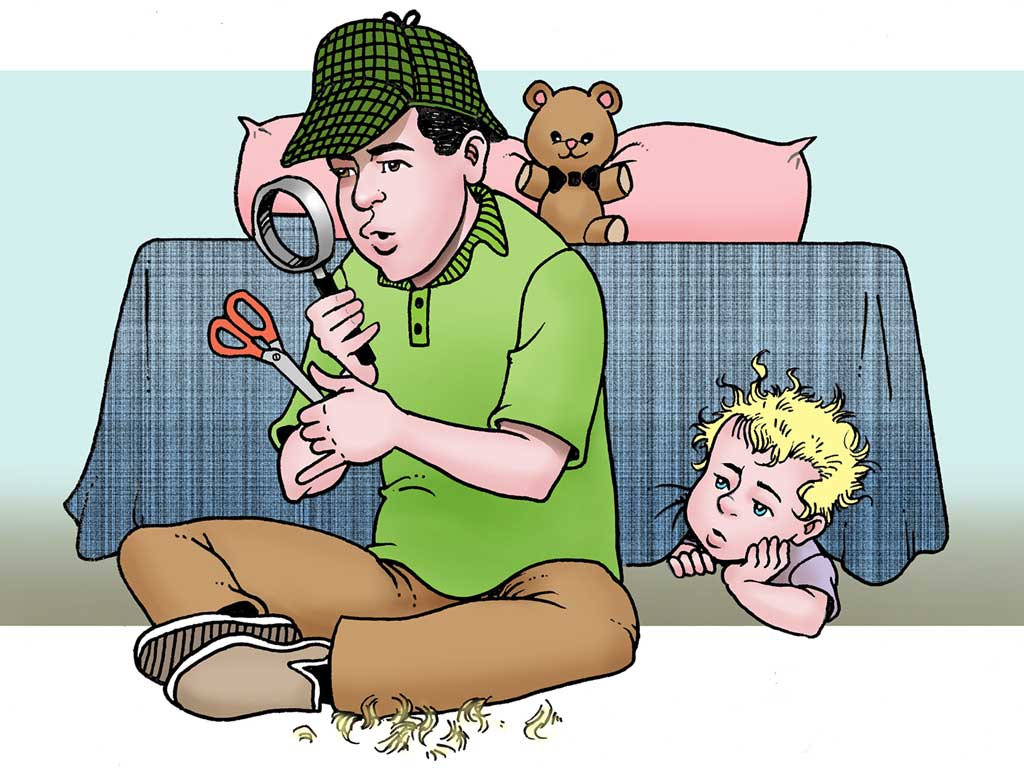by Rick Epstein
It was not a case for Sherlock Holmes. The physical evidence made one of those telltale little still-lifes that appear in the wake of active kids. It consisted of scissors and a handful of 4-year-old Sally’s fluffy blonde hair on the floor behind our bedroom door.
The classic crime-solving model – motive, weapon, opportunity – wasn’t necessary. With Sally, opportunity and weapon were all the motive she ever needed.
Not wanting to trap Sally in a lie, my wife Betsy confronted our little beauty operator by saying, “Sally, I know you cut your hair.”
Sally responded with apparent surprise: “Did I?!” It was hardly the remorseful confession that parents and police detectives like to elicit.
Her little sister at age 4 was less effective at deceit. One day while seated at the kitchen table for lunch, she announced, “There’s no spoons in MY underpants.”
I looked at her and she gave me a guilty smile. I picked her up and gave her a light shake. Clink. Clink.
Our oldest daughter Marie was usually too much of a pessimist to think she could get away with anything. But around age 10 she pulled off a neat series of forgeries. She would take a marker and write her own name on a banister or door, but she’d simulate Sally’s handwriting, drawing the “i” so it looked like a lollipop. Of course we thought Sally was trying to frame Marie. How did we figure out Marie was indeed the culprit? She told us last week. At age 24 she likes to reminisce.
“Why are kids so deceptive?” I asked my wife. “Or is it just OUR kids?”
“I think it’s ALL kids,” she said. “Sometimes they’re just testing our minds, and sometimes they act on impulse and then try to stay out of trouble. Didn’t you ever try to fool your parents?”
Suddenly I remembered The Incident of the Easter Candy.
When I was 7, Mom was commandant of my Cub Scout den, which meant that for a short time our rec room was the warehouse for 10 boxes of Easter candy. The Scouts would be dropping by to get the candy for delivery to the people who’d ordered it. Alone in the rec room and feeling curious, I opened one of the boxes. It contained a dozen chocolate eggs individually wrapped in cellophane. Who’d miss one? With heart thumping, I unwrapped one of them and took a bite. The inside was white, creamy and coconutty, and some confectionary genius had found a way to color the center yellow to simulate a yolk. It was exquisite.
By the end of the day, I’d been through all 10 boxes, devouring one egg from each and loosely rearranging the 11 survivors to conceal my theft. Wasn’t that a lot of candy? Not for a pig like me. Besides, how would it look to have 11 candies in some boxes and 12 in others? After my feast, I took all the cellophane outdoors and compounded my crime by throwing it into the storm sewer.
The next day Mom said to Dad, “There are supposed to be 12 eggs in each of those boxes, but I’m counting only 11. I’m going to have to call the candy company and get this straightened out.”
I hesitated, then said, “Mom…”
I could steal candy, but I could NOT let my mother embarrass herself. Mom already knew about my gluttony, but she was pleasantly surprised by my loyalty. She was grateful for my well-timed confession.
I didn’t know it, but I was preparing for adolescence when I would lead a secret life of adventure. It is part of a process called “individuation,” which covers everything parents don’t like about teenagers. And it wasn’t just me; it’s most kids. Think of every kind of mischief you got into as a teenager. Then imagine what you could have arranged if you and all your friends had cell phones.
I’m glad to say that two of my three daughters have already lived through it and joined me on the other side as adults. The 17-year-old is doing OK, but it would be naïve to say that her underwear is 100% spoon-free.





